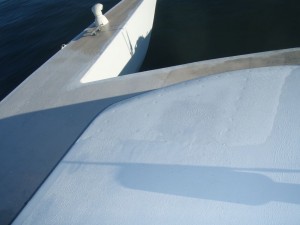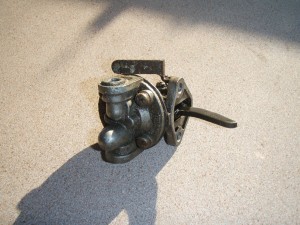I may not be warm, but at least I have an engine that starts.
Ok seriously, it’s fracking cold out here. The past few days the temperature has dropped further and further, and as I write this it is 6pm, pitch dark outside and -6°C. I know some of you are reading this from the Prairies or the Maritimes, where the ambient temperature has been hovering around -20°C, but I’m going to go ahead and assume that you also have furnaces and insulation and such. Tie Fighter is made of 3/8″ marine-grade plywood over cedar stringers, with an R-value of… god, I have no idea. Not enough, anyway. It’s COLD.

I’ve had some questions posed about insulating the boat, and the short answer is: I’m still researching. One school of thought says that the only way to insulate a wooden boat is to use foam rubber, and bond the foam directly to the wood, being careful not to leave any air gaps between the wood and the foam. The reasoning is that if you leave air gaps, you’re inviting condensation, which to wood means mildew or eventually rot.
The other school says that you should never bond anything to the wood, because that makes it much more difficult to notice problems, and a helluva mess to work with. They say to rather allow it to breathe and stack insulation over top that can have air forced in behind it via fans or blowers, so that the condensation can dry up on its own.
What am I going to do? I have no idea. I’m still soliciting opinions from various liveaboard forums and fellow False Creek denizens. For now, I’m toughing it out and burning several different forms of fossil fuels at the same time trying to stay warm. When I woke up this morning I had to break up the ice in the sink dishes before I could make breakfast.
Cold aside, I HAVE A WORKING ENGINE AGAIN! The diesel engine theory class paid off in spades, and I was able to diagnose the problem, correct the situation, and get Maude started. This was a huge boost to my confidence and self-esteem, especially given the nature of the problem and my previous (complete lack of) experience with engines.
To recap; Maude had started to lose power at some point during my last run up to fill my water tanks. The change was gradual but immediately noticible; the engine dropped in power without my touching the throttle, which is up there with “sounds different” or “emitting smoke” or “smells funny” on the diesel engine scale of uh-ohs. Not quite ‘explosion’, but definitely not good.
The most immediate difference between my response to this problem after having completed the diesel theory class vs. my response before the diesel class is that I now have any response at all other than ignoring the problem and hoping that it will resolve itself. Carrie once said to me “I don’t deal with little problems anymore. Little problems either go away on their own, or they become big problems. I deal with big problems.”. I took this somewhat to heart, but I have come to realize that that philosophy can only apply to some aspects of life; in other situations – diesel engines being a noteworthy example – it’s best to deal with little problems immediately and with extreme prejudice. Don’t just solve problems, smash them out of existence with the largest hammer you can find.

Maude had started to lose power, and I ignored it. The next time I tried to go for water, Maude died about four minutes into the voyage. Fortunately the incoming tide pushed me directly back over my anchoring spot, or I would have had to radio the Coast Guard for assistance. Attempting to restart her seemed to work intermittently, she’d start but die as soon as I applied any throttle, which is exactly the behavior one would expect from water in the fuel lines. The answer there would be to drain the water from the fuel lines, bleed the lines of any newly-introduced air, and then restart the engine – bearing in mind that the “bleed the lines” portion of that answer is an eleven-step procedure requiring three different sizes of wrench.
Needless to say, I was unsuccessful with the bleeding of the lines. For the life of me, I could not seem to get the air out of the lines; I must have pushed that little fuel lift pump lever tens of thousands of times, blistering and scraping my hands in the process. Nothing seemed to work!
Fortunately I had signed up weeks before for the Cooper Boating ‘Advanced Diesel Theory’ class, and so I went to class and paid close attention, asking so many questions that I’m sure the teacher is glad to be rid of me. Each week I returned from class with fresh resolve and a new set of hints, and spent a few hours poking at the engine trying to figure out what part of the bleeding process I was doing wrong. Each week I was unsuccessful.
After five straight weeks trying to perform the relatively simple process of bleeding the lines, I decided that I was doing it right and that there must be something actually wrong with the process. I decided to take each part in turn and track out the problem, just like I’d do with a computer issue. Eventually this led me to a conclusion: the fuel lift pump just wasn’t lifting fuel.

Long story short, I pulled the fuel lift pump off the engine and disassembled it on my kitchen table. I found that the input valve assembly was clogged in the ‘open’ position with a motley assortment of plastic scraps, gelled diesel and hair(?!), which I removed. This was clearly a result of the stock fuel filter having been removed by a previous mechanic and a third-party fuel filter installed instead, after the fuel lift pump instead of before it. I cleaned up the pump, tested and reinstalled it, changing the location of the fuel filter along the way – but still I had no fuel flow!
Finally, after putting together a bit of critical information from the instructor along with a tidbit from the guys at Stem to Stern, I realized that the copper washers in the banjo bolts connecting the fuel lift pump to the fuel lines must be letting air into the lines. I replaced the copper washers, tightened up the banjo bolts, and suddenly fuel began to flow. I performed the rest of the air-bleed procedure, cranked the engine, and low and behold Maude shuddered to life.
Anyhow. I have an engine again, though I haven’t yet installed the secondary fuel filter I purchased, nor replaced the belts, nor replaced the exhaust tank. I have yet to change the oil, either in the engine block or in the transmission. I haven’t even begun to reroute the cooling system, changing it over from raw seawater to antifreeze – but all of these projects will come. I have a working engine, and with a little luck I can keep it that way. I am no longer afraid of Maude. The engine is no longer a black box.
Just to add to the stress of the bitter cold, the police have just motored past in their ‘R.G. McBeath’ policeboat, which is the one they use to enforce the anchoring bylaws – they didn’t stop by to chat, but they’re weaving in around the anchored boats, making their presence known. I don’t have any idea what is going to happen to those of us squatting here in False Creek. I suspect we’ll all be kicked out prior to the Olympics, but I don’t have any good ideas on where to go after that – there really aren’t any other good, sheltered anchorages around Vancouver. The hard winter might shortly become much, much harder.
Congrats on the engine, up here in the river I’m slowly being locked in ice, it just keeps getting thicker and thicker, as it is now i can bounce a pebble off it, if it doesn’t warm up soon, I think I’ll be able to walk around my boat.